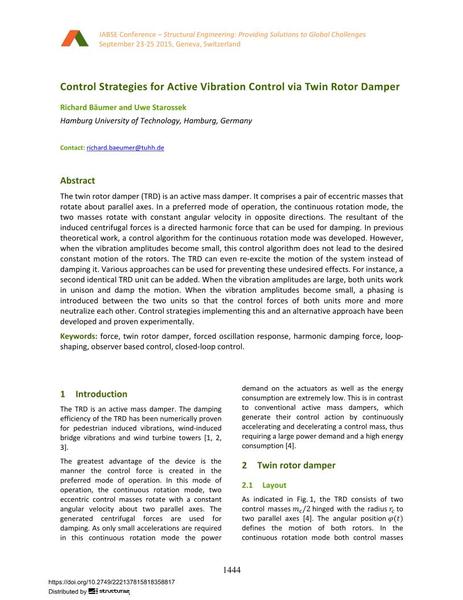Control Strategies for Active Vibration Control via Twin Rotor Damper

|
|
|||||||||||
Bibliographic Details
| Author(s): |
Richard Bäumer
(Hamburg University of Technology, Hamburg, Germany)
Uwe Starossek |
||||
|---|---|---|---|---|---|
| Medium: | conference paper | ||||
| Language(s): | English | ||||
| Conference: | IABSE Conference: Structural Engineering: Providing Solutions to Global Challenges, Geneva, Switzerland, September 2015 | ||||
| Published in: | IABSE Conference Geneva 2015 | ||||
|
|||||
| Page(s): | 1444-1451 | ||||
| Total no. of pages: | 8 | ||||
| Year: | 2015 | ||||
| DOI: | 10.2749/222137815818358817 | ||||
| Abstract: |
The twin rotor damper (TRD) is an active mass damper. It comprises a pair of eccentric masses that rotate about parallel axes. In a preferred mode of operation, the continuous rotation mode, the two masses rotate with constant angular velocity in opposite directions. The resultant of the induced centrifugal forces is a directed harmonic force that can be used for damping. In previous theoretical work, a control algorithm for the continuous rotation mode was developed. However, when the vibration amplitudes become small, this control algorithm does not lead to the desired constant motion of the rotors. The TRD can even re-excite the motion of the system instead of damping it. Various approaches can be used for preventing these undesired effects. For instance, a second identical TRD unit can be added. When the vibration amplitudes are large, both units work in unison and damp the motion. When the vibration amplitudes become small, a phasing is introduced between the two units so that the control forces of both units more and more neutralize each other. Control strategies implementing this and an alternative approach have been developed and proven experimentally. |
||||
| Keywords: |
force twin rotor damper forced oscillation response harmonic damping force loop shaping observer based control closed-loop control
|
||||
